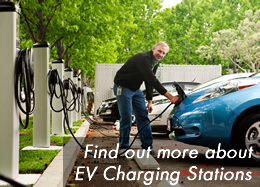Elk Horn, Iowa: an Oasis for Electric Cars
Here’s something you probably didn’t know about the town of Elk Horn, Iowa: it has America’s highest concentration of electric vehicle charging stations.
The Danish windmill in Elkhorn, behind a sign for a charging station
“Highest concentration” awards are relatively easy to come by when your population is 650. (Elk Horn also has the highest concentration of Danish immigrants; its residents say its interest in alternative energy derives from the homeland.) The town has four electric charging stations, one at a solar-powered service station, one in a parking lot, one at the hotel, and one by the Danish windmill, the town’s greatest tourist attraction.
The charging stations came to Elk Horn last November thanks to Mike Howard, a 57-year-old local entrepreneur who owns two businesses that test and calibrate alternative energy devices. You might say that he is so far ahead of the curve that, looking back, the curve can’t even be seen. Elk Horn itself only has four purely electric vehicles, and those all belong to Howard’s own businesses. “We’re our own best customers,” admits Trevor Schroeter, a project manager at World Cal, one of Howard’s companies. The chargers cost about $7,000 apiece, but a charge runs no more than $3.
While the idea of one charger per car might appear “ludicrous,” says Schroeter, consider this: In the vast stretch of Interstate 80 running between Chicago and Denver, there was nowhere to charge an electric vehicle, unless you were going to bum some electricity off a stranger. Now there is. Electric charging stations can be found all over the state of California (the Bay Area alone has about 130 listings on this site), but in the Midwest, Elk Horn is an electric oasis.
Maybe that’s why Howard and Schroeter are already planning on installing upgraded stations within the next month, capable of reducing the charging time from six hours down to three. They’re also working with partners in Iowa, Illinois and Nebraska to expand the EV infrastructure there. The hope is that each new station will help diminish the “range anxiety” surrounding electric vehicles, which in their smaller and cheaper incarnations sometimes only get 40 miles to a charge.
Never mind that the cars aren’t there yet. There’s a saying about this, already associated with rural Iowa: If you build it, they will come.
Join us in Copley Square for an open air event showcasing electric vehicles and public information on Wednesday September 15th. Copley Square – Back Bay, on the Boylston Street side of Copley Square.
September 9, 2010 by carbonday
Filed under Blog, Calendar, Carbon Day Festivals, Carbonday Festivals, Media, News
The event will be held from 10 am to 3:00 pm.
 Personal hybrid and all electric transportation of the near future, from trucks to bicycles, will be on display in Copley Square. Creators, manufacturer’s representatives, and owners will be on hand to answer questions and hand out information about their vehicles. Learn about the future city network of charging infrastructure that will be available as well as what Smart Neighborhoods and the Smart Grid can do. Participants include MIT Electric Vehicle Team, ConVerdant Vehicles, National Grid, Wheego, Vectrix Corp., Segway of Boston, MyBike, and Massachusetts Department of Energy Resources – Clean Cities Coalition.
Personal hybrid and all electric transportation of the near future, from trucks to bicycles, will be on display in Copley Square. Creators, manufacturer’s representatives, and owners will be on hand to answer questions and hand out information about their vehicles. Learn about the future city network of charging infrastructure that will be available as well as what Smart Neighborhoods and the Smart Grid can do. Participants include MIT Electric Vehicle Team, ConVerdant Vehicles, National Grid, Wheego, Vectrix Corp., Segway of Boston, MyBike, and Massachusetts Department of Energy Resources – Clean Cities Coalition.
Free to the public, we invite area schools, businesses, and all interested people to come see what your electric personal transportation options look like.
Sponsored by Boston University Center for Energy and Environmental Studies and Clean Energy and Environmental Sustainability Initiative jointly with the Electric Vehicle Urban Infrastructure Study (EVUIS).
ABC7 Profiles Carbon Day
Solar Station Press Kit
Please click below to access our Solar Station Press Kit.









